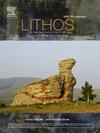Growth processes of zircon crystals in a granitic magma chamber, variation in UPb age, titanium concentration, and Th/U in relation to internal texture
IF 2.9
2区 地球科学
Q2 GEOCHEMISTRY & GEOPHYSICS
引用次数: 0
Abstract
This study describes the growth characteristics of zircon crystals in the Kuki granite from the Kitakami Mountains in northeastern Japan as the key for elucidating granitic magma chamber processes. Using two approaches, analyses based on multiple sections of separated zircon crystals and thin-section-based zircon crystal analyses, we determined the characteristics of the 3D internal structure of the crystals, variations in U![]() Pb age, Ti concentrations, and Th/U in relation to crystal texture, and the crystallization sequence between zircon crystals and other minerals (i.e., biotite, quartz, and K-feldspar) within the magma chamber. The textures, which occupy a large proportion of zircon, comprise low luminescence homogeneous cores (LLCs) and oscillatory zoning (OZ). The 3D distribution of the zircon internal structure can be classified into three types: Type 1 zircon comprising LLCs and the surrounding OZ and Types 2 and 3 zircon crystals composed entirely of OZ from the cores to the rims and characterized by brightness and darkness cores, respectively. LLC and OZ grew at temperatures from approximately 900 to 800 °C and 850 to 700 °C, respectively, and LLC has a higher Th/U than that of OZ, indicating that fractional crystallization progression as the magma chamber cooled resulted in the transition from LLC to OZ. In the progression of fractional crystallization, the diffusion rate deceleration with decreasing magma temperatures triggered the transition from interfacial reaction-controlled growth producing LLC to diffusion-controlled growth producing OZ. In the thin-section analysis, zircon crystals which contained in different minerals are characterized by different Th/U values. The variation in Th/U and the crystallization temperature of zircon crystals considering the surrounding minerals can be used to elucidate the differentiation and mineral crystallization in magma chamber processes over a wide range of temperature conditions.
Pb age, Ti concentrations, and Th/U in relation to crystal texture, and the crystallization sequence between zircon crystals and other minerals (i.e., biotite, quartz, and K-feldspar) within the magma chamber. The textures, which occupy a large proportion of zircon, comprise low luminescence homogeneous cores (LLCs) and oscillatory zoning (OZ). The 3D distribution of the zircon internal structure can be classified into three types: Type 1 zircon comprising LLCs and the surrounding OZ and Types 2 and 3 zircon crystals composed entirely of OZ from the cores to the rims and characterized by brightness and darkness cores, respectively. LLC and OZ grew at temperatures from approximately 900 to 800 °C and 850 to 700 °C, respectively, and LLC has a higher Th/U than that of OZ, indicating that fractional crystallization progression as the magma chamber cooled resulted in the transition from LLC to OZ. In the progression of fractional crystallization, the diffusion rate deceleration with decreasing magma temperatures triggered the transition from interfacial reaction-controlled growth producing LLC to diffusion-controlled growth producing OZ. In the thin-section analysis, zircon crystals which contained in different minerals are characterized by different Th/U values. The variation in Th/U and the crystallization temperature of zircon crystals considering the surrounding minerals can be used to elucidate the differentiation and mineral crystallization in magma chamber processes over a wide range of temperature conditions.

求助全文
约1分钟内获得全文
求助全文
来源期刊

Lithos
地学-地球化学与地球物理
CiteScore
6.80
自引率
11.40%
发文量
286
审稿时长
3.5 months
期刊介绍:
Lithos publishes original research papers on the petrology, geochemistry and petrogenesis of igneous and metamorphic rocks. Papers on mineralogy/mineral physics related to petrology and petrogenetic problems are also welcomed.
 求助内容:
求助内容: 应助结果提醒方式:
应助结果提醒方式:


